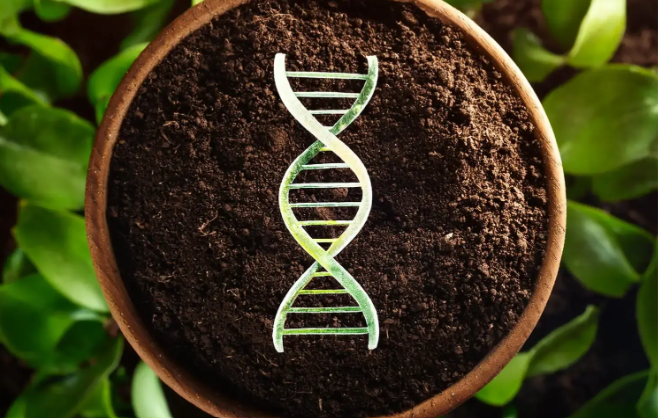How To Improve the Soil Microbiome
The soil microbiome is the invisible engine of terrestrial life. Composing a rich network of soil bacteria, fungi, archaea, protozoa, viruses, and...
4 min read
 Manoj Dadlani
:
May 7, 2025 5:35:04 AM
Manoj Dadlani
:
May 7, 2025 5:35:04 AM

Beneath our feet lies an intricate and dynamic world that is fundamental to life on Earth: the soil microbiome. This term refers to the vast and diverse community of soil microorganisms — including bacteria, fungi, archaea, and viruses — that inhabit the upper layers of soil. These microscopic organisms play a critical role in maintaining soil health, supporting plant growth, and ensuring the proper functioning of natural ecosystems.
The soil microbiome regulates vital soil functions, including nutrient cycling, soil structure formation, and the suppression of plant diseases. It forms a key interface between the biotic and abiotic elements of ecosystems, influencing plant roots, soil fertility, and soil carbon storage.
Given its integral role, understanding the soil microbiome has become essential for advancing sustainable agriculture, enhancing environmental health, and building climate resilience.
Explore advanced soil microbiome research services with Cmbio
The soil microbiome directly contributes to plant health by forming symbiotic relationships with plant roots and enhancing nutrient availability. Soil microbes, particularly arbuscular mycorrhizal fungi and nitrogen-fixing bacteria, assist in the uptake of essential elements such as nitrogen, phosphorus, and potassium. These beneficial microbes improve plant growth promotion by producing plant hormones, enhancing stress tolerance, and outcompeting pathogenic microbes.
Recent research published in Frontiers in Plant Science (2024) affirms that soil microbial communities increase crop yields and resilience by improving soil texture and boosting the availability of macro- and micronutrients. These communities contribute to the formation of disease suppressive soils, where the presence of diverse bacterial communities helps prevent the proliferation of soil borne pathogens.
The soil microbiome also supports larger ecological functions, including carbon sequestration, soil erosion prevention, and participation in the global nitrogen cycle. By increasing soil organic matter and stabilising soil particles, microbial life enhances the soil's ability to retain soil moisture, buffer against environmental stress, and reduce nutrient loss. This not only promotes healthy soil, but also protects human health through cleaner air, water, and more nutritious food systems.
A wide array of environmental and anthropogenic factors influence the microbial community structure and microbial diversity within soil ecosystems.
The type and intensity of soil management practices—such as tilling, crop rotation, and organic amendments—have a direct impact on the relative abundance of different microbial communities. Practices that enhance soil organic matter tend to promote soil microbial biomass and overall soil microbial diversity.
Excessive use of chemical fertilizers, herbicides, and pesticides can negatively impact soil microbial communities, reducing bacterial diversity and the abundance of fungal community members. These substances may also foster harmful microbes, weakening the soil community's ability to resist disease.
Variability in temperature and precipitation patterns alters soil moisture, directly affecting microbial biomass and shifting the microbial community composition. Climate change has been shown to disrupt soil microbiota, particularly in areas with increased drought or extreme weather events.
The composition of soil particles, pH levels (soil pH), and the presence of organic matter determine the habitat conditions for soil microbes. Loamy soils with high soil carbon and organic matter generally support greater microbial diversity compared to sandy or degraded soils.
A disruption in microbial community structure can lead to poor soil quality, reduced productivity, and increased susceptibility to plant diseases.
Just as the human gut microbiome depends on dietary input, the root microbiome is influenced by crop selection and rotation. Monotonous diets—repeatedly planting the same crops—limit plant diversity and reduce the diversity of associated soil microbial communities.
These inputs can eliminate beneficial microbes while allowing pathogenic microbes to thrive, creating imbalanced soil microbial communities that negatively affect plant microbiome development and agricultural production.
Repeated tilling disrupts soil structure, breaks apart microbial habitats, and increases oxidation, which can lower soil carbon storage and bacterial biomass.
Monocultures reduce plant root diversity, weakening the soil microbiome by limiting the range of microbial niches and promoting uniform, less resilient bacterial communities.
Shifts in rainfall, temperature extremes, and elevated CO₂ levels alter soil microbial diversity and can reduce the abundance of disease suppressive soils, increasing vulnerability to soil borne pathogens.
Restoring microbial balance is essential for developing sustainable agriculture systems that are both productive and environmentally sound.
Applying compost, manure, or biochar introduces new microbial communities and feeds existing ones. This practice increases soil microbial biomass, enhances soil fertility, and supports microbial community composition recovery.
Crop rotation, agroforestry, and reduced chemical inputs all support microbial diversity and foster soil functions that benefit healthy plants and long-term productivity.
Adopting integrated pest management (IPM) reduces reliance on synthetic chemicals, preserving beneficial microbes and allowing for the development of disease suppressive soils.
Cover crops increase plant diversity, supply organic matter, and protect against soil erosion. When incorporated into the soil, green manure provides nutrients that feed a wide array of soil microorganisms.
Practices such as no-till or reduced-till farming preserve soil structure and support the long-term stability of microbial community structure, protecting against degradation and maintaining soil quality.
The soil microbiome is a cornerstone of Earth’s ecological stability and human food systems. Its health determines not only the fertility and structure of soil but also the capacity of ecosystems to adapt to climate change, resist disease, and sustain productivity.
By understanding the drivers of microbial diversity and implementing practices that support a balanced soil community, we can ensure a more resilient and regenerative future for agriculture and the environment.
Learn more about out soil microbiome research services
Soil bacterial communities play a critical role in supporting plant health by facilitating nutrient cycling, producing growth-promoting hormones, and enhancing the availability of essential minerals like nitrogen and phosphorus. These beneficial microbes also help suppress soil borne pathogens through competitive exclusion and production of antimicrobial compounds. A diverse and balanced soil bacterial population contributes to a resilient root microbiome, leading to stronger, more productive plants.
Soil fungi, particularly arbuscular mycorrhizal fungi, are vital to agricultural sustainability due to their symbiotic relationships with plant roots. They extend the root system’s access to water and nutrients, particularly phosphorus, while improving soil structure and stability. By enhancing soil functions such as carbon sequestration and disease suppression, soil fungi support long-term soil health and reduce dependence on chemical fertilizers in sustainable farming systems.
Understanding the composition and function of the soil microbiome, including soil bacterial communities and soil fungi, is essential for maintaining soil quality and promoting agricultural sustainability. Healthy microbial communities contribute to soil fertility, regulate the global nitrogen cycle, and protect against plant diseases. Monitoring and managing the soil microbiota ensures ongoing plant health, improves crop resilience, and supports ecosystem services critical to food security and climate adaptation.

The soil microbiome is the invisible engine of terrestrial life. Composing a rich network of soil bacteria, fungi, archaea, protozoa, viruses, and...

Your mouth is home to a thriving community of tiny organisms, collectively known as the oral microbiome. These microbes—including bacteria, fungi,...

The skin is the largest organ of the human body, serving as a crucial barrier between our internal systems and the external environment. The human...